Cucumbers are a popular crop in most home gardens. Growing them is easy, but proper depth and spacing lead to healthy and productive plants. Today’s article talks about how deep and far apart to plant cucumbers.
In-ground planting, sow the seeds ½-1 inch deep and 10-12 inches apart. The depth remains the same for the transplants, whereas the space is 3-4 feet. For trellis, the depth stays the same, whereas the spacing for seeds is 4 inches, and seedlings are 6-8 inches.
Besides ground and trellis planting, several other factors will determine the depth and spacing of the cucumbers. Read this article till the end to know the correct planting techniques for cucumbers in detail.
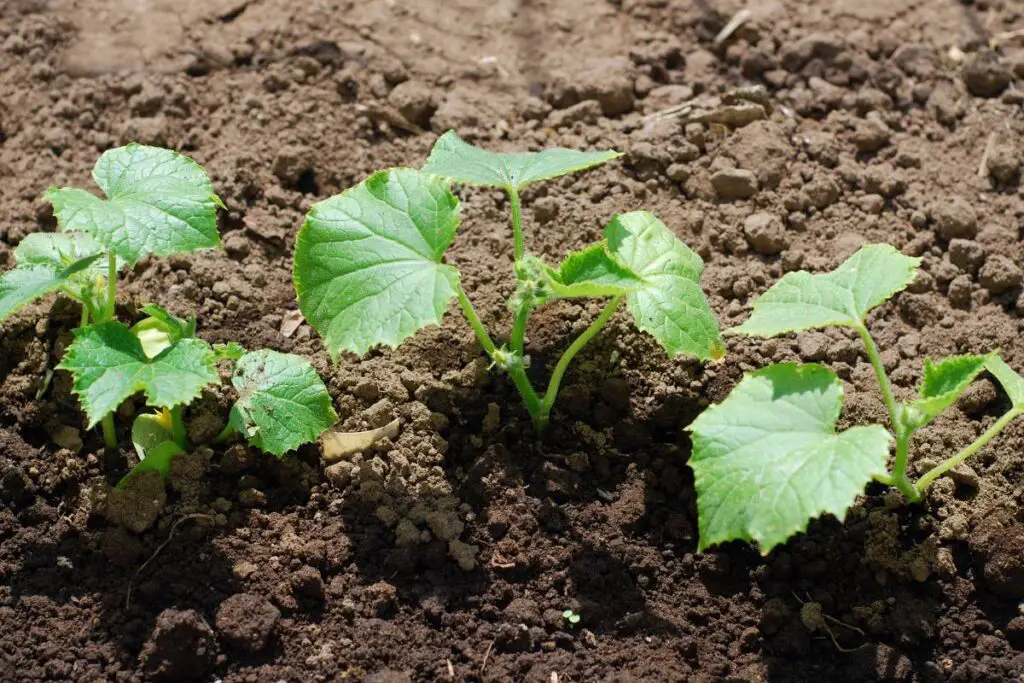
Introduction to cucumber planting guidelines
Knowing the proper guidelines to plant and grow cucumbers leads to a successful outcome.
Your plant gets filled with fresh and plumpy cucumbers.
Here’s a brief guideline about cucumber planting and care:
- Choose a suitable variety; for example, cold or heat-resistant according to your zone, disease-resistant, easy to care for, the purpose of growing the specific variety, and so on.
- The right time is 2-3 weeks after the last spring frost when the soil temperature reaches 60 to 65°F.
- Cucumbers need well-drained, loamy, and nutrient-rich soil with 6-6.5 pH levels. Before planting, add organic matter to the soil to make it ideal for the cucumbers.
- Plant the seeds or seedlings 1 inch deep and 3-4 feet apart. The depth remains unchanged, but the spacing may vary based on the growing techniques and varieties.
- Ensure the cucumbers receive at least 6-8 hours of sunlight daily.
- Water them with 1-2 inches of water per week. During the hot summers, water them 2-3 times weekly.
- One fertilization is done at the time of planting by adding organic matter. The next one should be after the plant reaches a few inches. Add liquid fertilizer every 2 weeks or slow-release every month.
- For extra spacing and healthy growth, I would prefer using a trellis. It can support the vines and provide more space in your garden to grow more plants.
- Protect your plant from extreme temperatures. In the cold weather, take them inside or cover them with row covers or frost blankets. During hot temperatures, provide some shade during the hottest time of the day and water them more often. Add a layer of mulch in both cases.
- Monitor your plant regularly and check if any signs of stress or infestation have occurred. Once you detect the problem, immediately treat your plant to revive it.
Importance of proper planting depth
It is crucial to use appropriate planting methods to ensure that plants grow and develop healthily.
So, plant the cucumber seeds or seedlings with proper depth. It should be neither too shallow nor too deep.
Below are some reasons why proper planting depth is vital:
- Cucumbers have a shallow root system. The correct depth is essential for the roots to receive oxygen, nutrients, and water.
- Maintaining the correct depth ensures the seeds germinate at the right time and do not get carried away by wind, water, or rodents. It also allows the seed to contact the warm soil surface for germination.
- With the correct depth, the cucumber seeds and seedlings will receive enough sunlight without struggling for photosynthesis.
- Cucumbers planted at the correct depth encourage a robust root system to keep the plant in place. It is essential because the cucumbers have trailing vines that need a robust root system for support.
- With the correct depth, the stem will stay above the ground, healthy, and reduce the risk of soil-borne diseases and rotting.
Determining the right depth for the cucumber planting: Factors affecting the depth
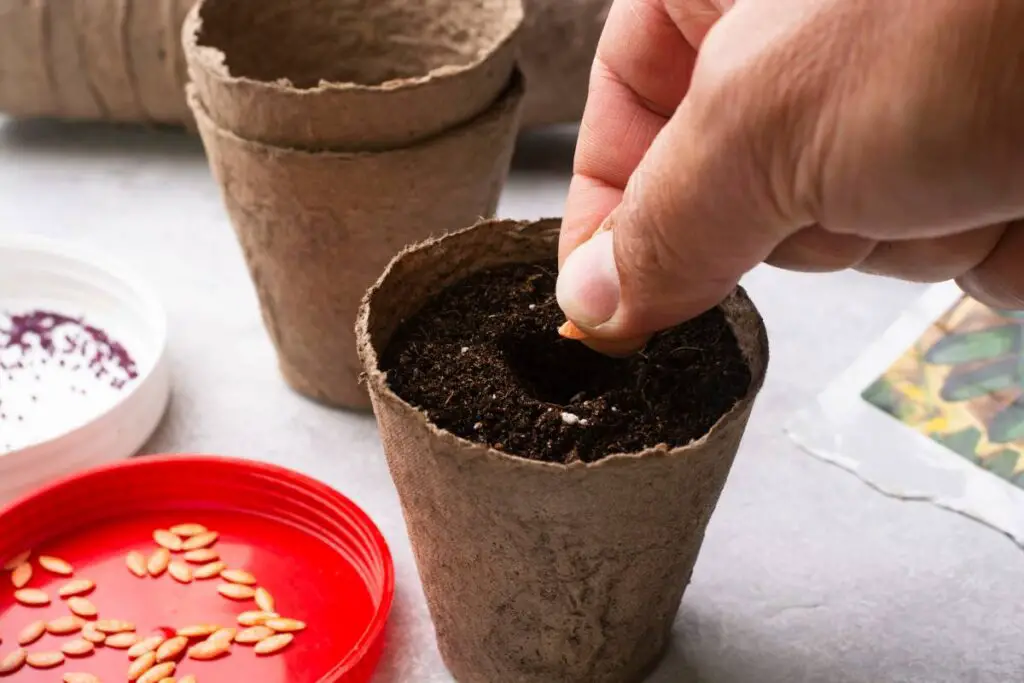
To determine the proper planting depth for the cucumbers, consider a few factors that can affect the depth.
However, unlike the spacing between the cucumbers, only a few factors affect the depth of the cucumber planting.
In most cases, the depth remains around ½ inch to 1 inch.
Let’s look at the factors:
Direct sowing
Cucumber roots do not like to be disturbed.
So, most gardeners sow the seeds directly into the soil 2-3 weeks after the last frost.
Sow two seeds next to each other about 1 inch deep.
Once the seeds develop into seedlings, remove the weaker ones.
The 1-inch depth is ideal for the cucumbers as it will allow the roots to grow deep into the soil and anchor the plant.
It will also allow enough stems and leaves to grow above the soil surface.
Transplanting seedlings
If you have started the seeds indoors, you might have to transfer the seedlings outdoors for adequate sunlight.
Start the seeds 4-6 weeks before the last frost and transplant them 2-3 weeks after the last frost when the ground warms up.
Here also, you must plant them 1 inch deep into the soil and space them at least 12 inches apart for now.
As I said, the depth stays mostly the same for the cucumbers.
This depth allows the stems and leaves to stay above the soil surface.
Mounds
The depth remains the same here too.
Plant the seeds or transplants one inch deep.
But for spacing, maintain 4 feet of distance and sow 4-6 seeds per mound.
Planting the cucumbers in the mounds warms the soil faster and allows better drainage.
Seed size
This factor is considered a little by the gardeners.
But I have learned somewhere that the depth for sowing the cucumber seeds should be twice the size of the seeds.
If the seeds are slightly oversized, you can sow them slightly deeper, for example, 1.5 inches deep.
Importance of maintaining proper spacing
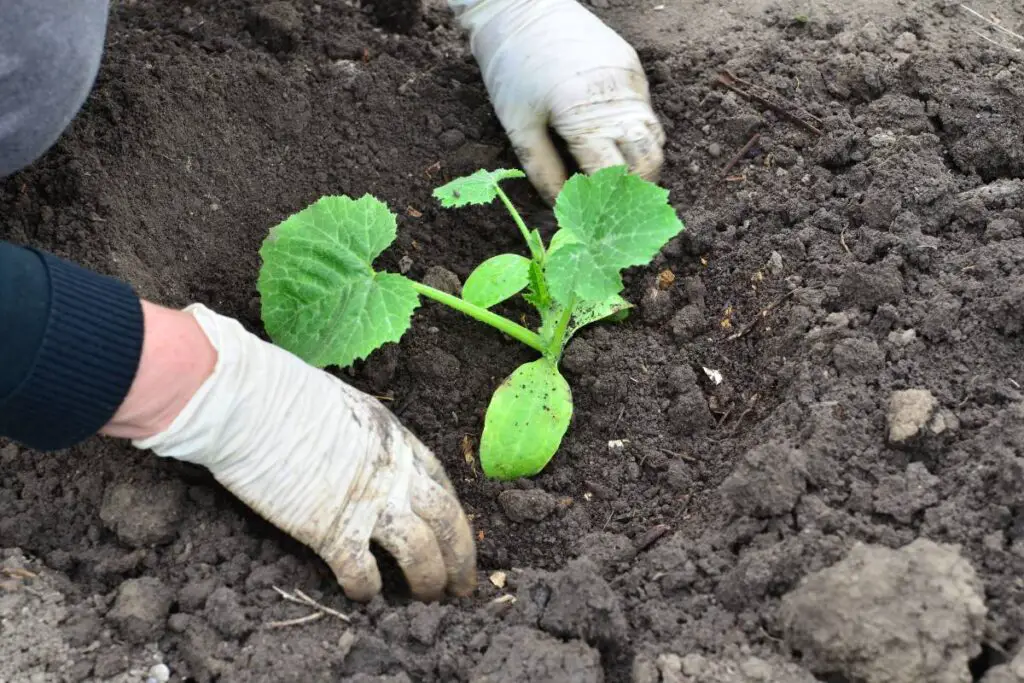
Before we get into the details of proper spacing between the cucumbers, it is essential to understand the need to maintain a suitable space between the cucumbers:
Looking for gardening supplies? We have tested 100's of products before recommending them to you guys. Check out our best pick below:
| Image | Gardening Supplies | Best Price? |
|---|---|---|
 Top
Top Top
Top | Raised Garden Bed Kit | Check On Amazon |
 | XLUX Soil Moisture Meter, Plant Water Monitor, Soil Hygrometer Sensor for Gardening, Farming, Indoor and Outdoor Plants, No Batteries Required | No Results |
 Top
Top Top
Top | 82 Pcs Garden Tools Set and Extra Succulent Tools Set | Check On Amazon |
 | Joeys Garden Expandable Garden Hose with 8 Function Hose Nozzle, Lightweight Anti-Kink Flexible Garden Hoses, Extra Strength Fabric with Double Latex Core, (50 FT, Black) | No Results |
 Top
Top Top
Top | Dual Chamber Compost Tumbler | Check On Amazon |
 Top
Top Top
Top | Sunnyglade Plant Stakes | Check On Amazon |
 Top
Top Top
Top | Organic Cold Pressed Neem Seed Oil | Check On Amazon |
 Top
Top Top
Top | Mighty Mint Gallon :-Insect and Pest Control Peppermint Oil | Check On Amazon |
 Top
Top Top
Top | Scotts DiseaseEx Lawn Fungicide | Check On Amazon |
 Top
Top Top
Top | Jacks Classic 20-20-20 All Purpose Fertilizer | Check On Amazon |
 Top
Top Top
Top | 30,000 Seeds Pollinator Attracting Wildflower Mixture | Check On Amazon |
 Top
Top Top
Top | Survival Vegetable Seeds Garden Kit-Over 16,000 Seeds | Check On Amazon |
Disease prevention
All plants are susceptible to diseases if conditions are made right, and cucumbers are no exception.
When the cucumbers are close to each other, the humidity increases, and the airflow decreases, therefore, encouraging diseases like botrytis blight and powdery mildew.
But with proper space, the humidity will remain controlled, and there will be enough air circulation.
In such a condition, the cucumbers will not develop any diseases.
Proper spacing also reduces the chances of disease spreading to the other plants.
Higher and better yields
With proper spacing, you get higher yields. Why? Here’re the reasons:
- The first reason is there will be no diseases with proper spacing. So, if the plant is healthy, it will, of course, encourage more yields.
- The following reason is the plants will get space to spread and breathe. With proper space, the plant can grow and reach its full potential.
- With enough space, the plants do not have to compete with each other for nutrients, sunlight, and moisture.
- With so many benefits, cucumbers are bound to produce the maximum yields.
Making the best use of the space
When you plant the cucumbers with proper spacing, you can make the best use of the space, especially when you grow them in trellis, fences, or arches.
With enough space between the cucumbers, you can check the plant closely.
You can quickly move between each plant and harvest cucumbers without tripping or bending.
Pest Prevention
Adequate spacing can deter pests because it encourages healthy and uncrowded cucumber growth.
Cucumber beetles, aphids, whiteflies, and squash bugs are the uninvited guests in the plants.
The lesser the crowd, the lesser the chances of pest infestation.
Additionally, the healthy plants are highly resistant to pests.
Spacing recommendations for the cucumber plants
Cucumbers have various shapes and sizes and need enough space to grow.
The minimum space to keep between the cucumbers is 1 foot for smaller varieties and 3-6 feet for the larger varieties.
But, several factors will determine the spacing, such as direct seed sowing, transplanting seedlings, ground-level planting, trellising, using containers, and varieties.
So, let’s explore these factors and understand the correct spacing for the cucumbers.
Cucumber spacing guidelines: Factors affecting the spacing
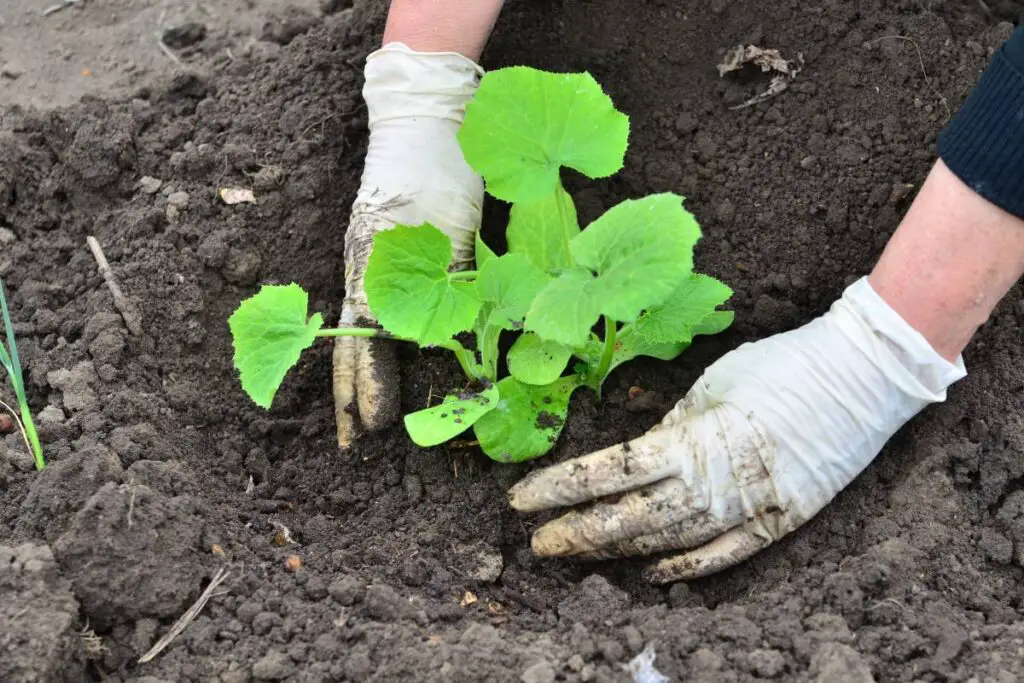
Below are some of the significant factors you need to consider while planting cucumbers in your garden:
Direct seed sowing
The right time to sow the seeds directly outdoors is only when the outdoor temperature is at least 70 to 75°F, and the soil temperature is at least 60-65°F.
Keep sowing every 2 weeks throughout the growing season for succession planting.
There are several ways to grow the cucumbers, and different ways will have different spacing.
You can grow a cluster of 3 seeds spaced every 3-6 feet along the row.
When the seeds germinate into seedlings, thin them to one seedling every 3-6 feet.
Some cucumbers prefer growing in mounds or hills.
If the hills are 4-6 inches high, plant the cucumbers 1-3 feet apart, based on the plant size.
In the mounds, sow 3-4 seeds per mound. When the seedlings sprout and grow a few inches, thin them out to 1 plant per mound.
While growing in the rows, keep the rows 18-24 inches apart and sow the seeds 10-12 inches apart.
Plant them in a group of 3 for group sowing, keeping 18 inches of distance between each group.
Spacing during transplanting
If you have started the seeds indoors, you have to transplant the seedlings outside 2-3 weeks after the last spring frost.
For the vining varieties, maintain 3 feet of space between each transplant.
While growing the transplants in rows, hills, or mounds, plant the seeds 3 to 6 feet apart.
This will provide the vines with enough space to crawl over the ground.
The larger varieties will need more space than the smaller varieties. So, you have to adjust accordingly.
Trellising
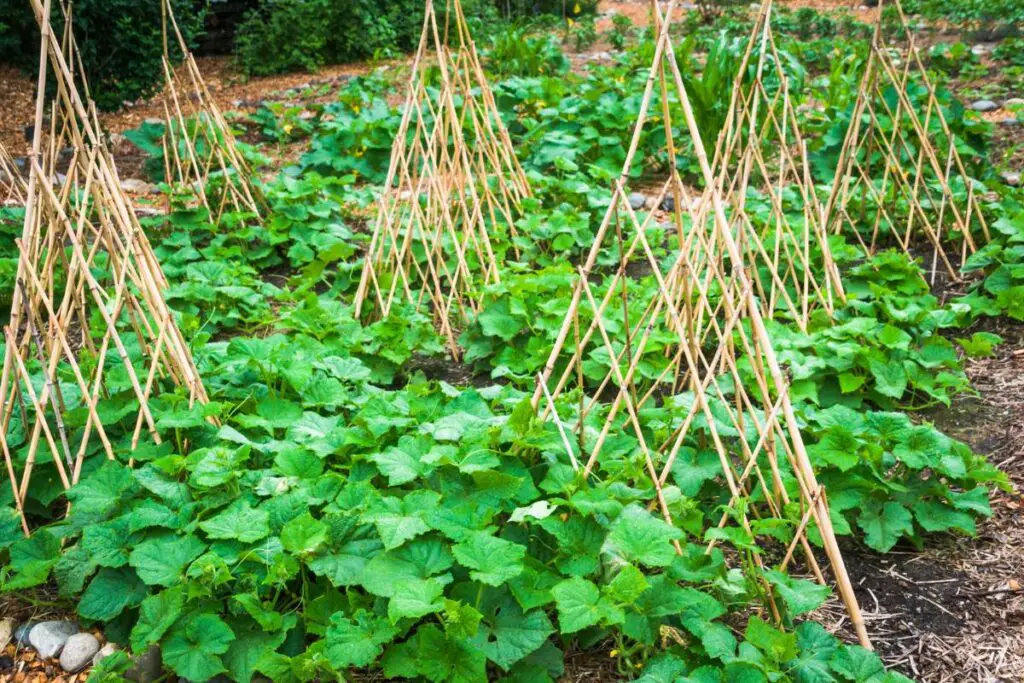
If vertical gardening, the cucumbers take up less space.
In that case, you can maintain a slightly less distance than the ground-level planting.
For sowing the seeds at the base of the trellis, maintain 4 inches of distance between each seed.
Maintain proper watering and fertilization so that the plants do not compete for them.
Train the vines to grow up the trellis.
For transplanting the seedlings from indoors to outdoors, plant them 6-12 inches apart at the base of the trellis, based on the plant variety.
The roots are already growing strong in the small pots.
So, you would need to reduce the chances of transplant shock by providing enough space so they don’t compete for moisture and nutrients.
Indoors in Containers
If you live in a colder zone, you will have a shorter growing season.
That is why some gardeners recommend starting the seeds indoors in the pots.
Sow the seeds 3 weeks before you plant to transplant them outside or 4-6 weeks before the last spring frost.
The right time for transplantation is the same as the direct sowing time, i.e., 2-3 weeks after the last spring frost.
The ground will thaw by then, and the soil temperature should rise to 70°F.
Plant 2 to 3 seeds per pot and plant them 1 inch deep.
If the planter is long, keep the vines 3 feet apart.
If the pot is smaller than 20 inches, there is no matter of spacing. Plant one vine per pot.
Cucumber varieties
The vine varieties can grow longer than the bush varieties.
So, whatever distance you maintain for the bush varieties, you need to keep twice the distance between the vine varieties.
Usually, you can keep 3 feet of distance between the bush vines and 3 feet between the rows.
The spacing for the vine varieties should be 3 feet between the vines and 6 feet between the rows.
Here is a small guide to different cucumber varieties and their spacing recommendations:
- Straight 8 cucumbers – Plant them 3 feet apart with 6 feet of distance between the rows for ground planting and 3 feet for trellising.
- Lemon cucumbers – Space them 3 feet apart with rows 6 feet apart. For trellising, maintain 3 feet distance both between the plants and the rows.
- Armenian cucumbers – Plant them 3 feet apart with rows 8 feet apart. For the trellis, it is 3 square feet per plant.
- Marketmore cucumbers – Plant them 3 feet apart with rows 6 feet apart. For the trellis, space them 3 feet between both rows and each plant.
- Muncher cucumbers – Plant them 3 feet apart with rows 6 feet apart. For the trellis, maintain 3 feet of distance between both rows and the plants.
Managing the cucumber plant density in containers
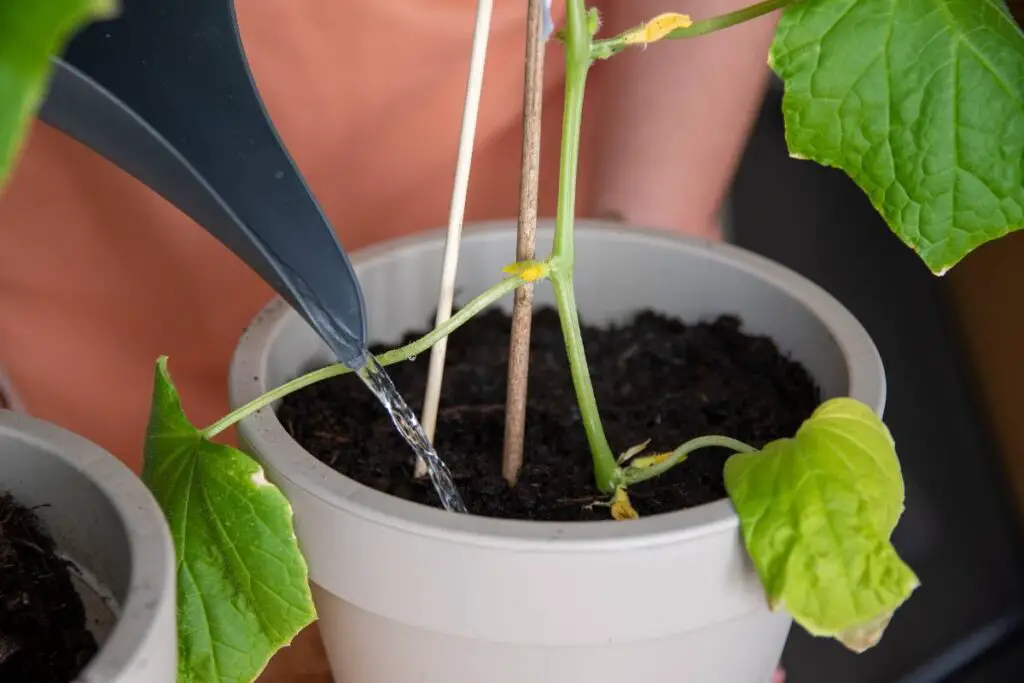
When growing the cucumbers in pots, it is not the spacing that matters here but the volume of soil the pot can hold.
It is crucial to manage the plant density in the containers.
The soil volume and the pot size should be enough to manage the plant’s density.
For a bush variety, plant 1 plant per 2-3 gallons of soil volume.
Plant 1 plant per 5 gallons of soil volume for a standard or vining variety.
A 5-gallon bucket with enough drainage holes will be great for the vining variety.
When growing the cucumber vines in a pot with the other plants, always err on the larger pot size.
If the pot is smaller than 20 inches, it will manage the density of one cucumber plant and support adequate growth.
For the pot is bigger than 20 inches, grow one vine for every 2 gallons of soil for good plant density management.
If you plan to add companion plants in the same pot as cucumbers, ensure the pot holds enough potting soil.
Please provide them with adequate moisture and nutrients to prevent competition.
Key considerations for companion planting with cucumbers
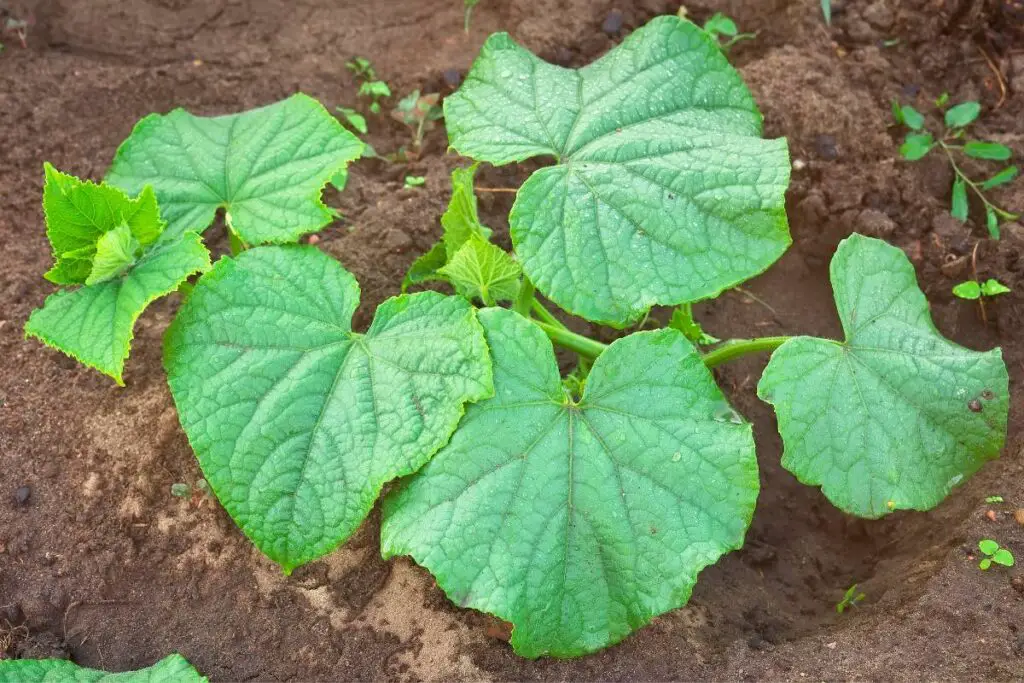
Growing cucumbers alone can be boring. So, gardeners grow some companions along with them.
It not only adds value to your garden, but the companions and the cucumber can benefit each other in various ways, for example, by providing shade, ample nutrients, attracting pollinators, and deterring pests.
There are many companions for cucumbers, for example:
- Legumes
- Corn
- Sunflowers
- Marigolds
- Nasturtiums
- Herbs like dill and oregano
- Root veggies like onion, garlic, carrots, and beets
To keep a proper distance between these companions and the cucumbers, you have to understand the growth patterns of all of them.
Provide them with enough space so that they can grow flexibly without any obstructions next to each other and also provide enough benefit for each other.
For example, if you grow flowers like nasturtiums and marigolds, keep at least 10 to 18 inches of distance between them and the cucumbers.
For growing veggies like radishes and beans, 1-2 feet distance between them.
There is no exact distance. You have to adjust it according to their root and plant growth patterns.
Step-by-step guide for planting the cucumber seeds
There are two ways to plant the cucumber seeds – direct sowing and indoors in containers:
Direct sowing
- Wait until the soil temperature reaches 65-70°F.
- Choose an ideal planting site for the cucumbers that can receive at least 6 to 8 hours of sunlight.
- Prepare the soil in the fall by digging around 25-30 cm of the topsoil. Remove the old plant roots, leaves, and weeds.
- Add organic matter and mix it well.
- If the soil gets degraded again, till the soil again, break the lumps, and add some organic matter.
- Next day, sow 2-3 seeds ½ to 1 inch deep, 3-6 feet apart along the row.
- If you prefer a trellis, 4 inches of distance. As they grow, maintain 1 foot of distance.
- Please provide them with adequate sunlight and moisture.
- After they turn into seedlings, thin out the weak ones and maintain 3 to 6 feet of distance between each seedling.
- Once the plant reaches a few inches tall, fertilize them with a liquid fertilizer every 2 weeks for 8 weeks. Continue providing them with all the requirements.
Indoors in pots
- Take a suitable pot size for the cucumbers. If the pot is smaller than 20 inches, plant one seed per pot. If it is larger, plant 2-3 seeds per pot only.
- Prepare an ideal potting mix. Refer to our soil article for ideal soil recipes.
- Fill the pot with the potting mix, and plant the seeds 1 inch deep into the soil.
- If you have taken a long or large pot, keep 6 inches of distance between each seed. As they grow into seedlings, thin out the weak ones and keep the healthy ones.
- When transplanting them outdoors, find the right planting site, and plant the seedlings 1 inch deep and 3-6 feet apart.
- For trellises, plant them 6 to 12 inches apart.
- Take care of them by providing adequate sunlight, moisture, and nutrients. Protect them during extreme weather conditions.
Here, I would suggest one thing.
While transplanting is an option, keeping them in pots or directly sowing them is better.
The cucumber roots do not want to be disturbed. When you transplant, expect to see transplant shocks in the plant.
Be patient, continue caring for them, and avoid any stress.
Troubleshooting the common planting depth and spacing issues
While planting the cucumbers, you must plant them at a proper depth with enough space in between.
Ignoring the correct planting techniques can lead to a lot of issues, and below are some common issues you might face if you do not maintain proper depth and spacing:
Problems related to improper depth
- If the seeds and seedlings are planted too shallow, they will quickly come out of the soil, get carried away by rain and floods, or be eaten by rodents.
- Planting the seeds too deep means the seed will take forever to germinate. The seeds must come in contact with the warm soil surface to germinate.
- When planting seedlings, make sure the stem is above the soil surface. If planted too deep, the stem will be buried. It can eventually rot, making the plant vulnerable to soil-borne diseases.
- Shallow will not make a robust root growth under the soil that can hold the plant.
Check the seeds and seedlings if you see any of the above problems.
If you have made mistakes, you have to correct them.
If you have planted them shallowly, dig the soil around the plant.
Either add more soil to reach the proper depth or dig more than before for the correct depth.
Remove some topsoil to troubleshoot deep planting until you reach the proper depth.
The roots of the cucumber plants will hate getting disturbed.
So, try not to disturb them as much as possible.
Problems related to spacing
- Close planting reduces air circulation between the plants and increases humidity. As a result, this gives rise to diseases like powdery mildew and botrytis blight.
- Close planting will lead to overcrowding. With overcrowding, the plants cannot receive enough space to grow and breathe. If it gets affected by any disease, it will spread rapidly among the other plants.
- The cucumbers have shallow roots that grow horizontally, with only one tap root that grows deep into the earth. In close planting, the roots do not receive enough room to spread and grow properly.
- When you plant the cucumbers too close to each other, they start fighting for moisture and nutrients, leading to stunted growth and lower yields.
- Since the cucumbers have vines, close planting will lead to the entangling of the vines with one another. It will create issues at the time of harvesting.
Several problems will occur when you do not provide enough space between the cucumber plants.
If you face any problems, check the distance between the cucumbers.
Sometimes, you plant 2-3 seeds together.
Please do not keep them like that once they grow into seedlings.
Thin them out and plant them at least 3 to 4 feet apart.
If the plants are too close to each other, the best solution is to remove them and plant them 3 to 4 feet away.
If a plant is affected by mildew or blight, isolate it and treat it with neem oil or fungicides.
Harvesting and Beyond What to Expect from proper planting practices
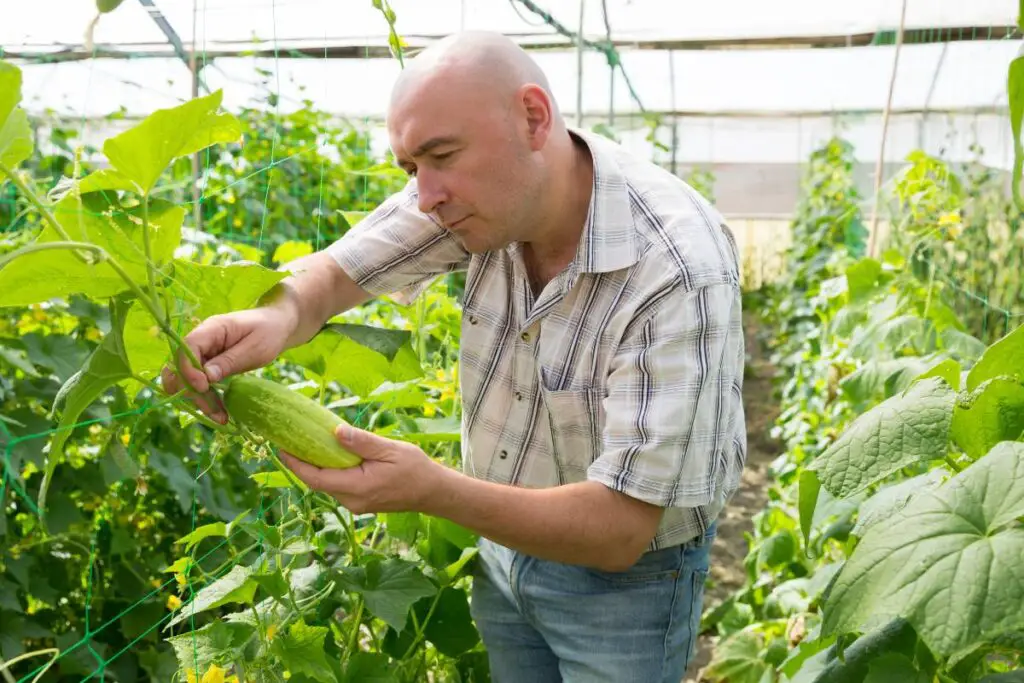
With proper planting depth and spacing, you will receive higher yields and healthy cucumbers ready for harvest at the right time.
With the proper spacing and depth, you can expect:
- Better and improved germination
- A robust root system that can hold the place in place
- Significant development and improved yields
- You receive optimal space between the cucumbers
- Easy to maintain and provide all the resources
- There are no pest or disease infestations
- You get enough space to move around between the plants and quickly harvest the fruits.
The plants grown by first-time growers may have a lesser yield in the first year.
But with proper techniques and maintenance, you can increase the yield over time.
To increase the yield, keep harvesting the mature cucumbers.
This will divert the plant’s energy into producing new fruits and stop focusing on forming seeds inside the existing fruits.
The cucumbers will get ready for harvest within 50 to 70 days after planting.
Pick up the ripe cucumbers every other day during the peak and off-peak seasons.
Each variety will take a different time to mature.
But, it is mostly between 50 and 70 days.
So, keep checking the cucumber fruits.
The mature size for the pickling variety is 2 to 4 inches, and the slicing variety is 6 to 9 inches and sometimes 10-12 inches.
The cucumber should be thick, plumpy, and have a rough or bumpy texture when mature.
Once mature, leaving 1 to 1.5 inches of stem, cut the cucumbers with a pruner and collect them in the basket.
Do not pull or twist the stem for picking the cucumbers, as that will damage the plant.
Final thoughts
Cucumbers are fun to grow in the summer. They love warm weather and are easy to grow and maintain. But you need to plant them correctly and take care of them. Be it seeds or transplants, plant them ½ to 1 inch deep.
Maintain at least 1 foot of space between them if you use a trellis. If not, plant them at least 3 to 6 feet apart. This ensures quick seedling growth and a robust root system.
Maintaining adequate space ensures proper airflow, no crowding, no pests and diseases, and enough breathing and oxygen for the plants. Also, you can easily move around and harvest them quickly.
How deep do the cucumber roots go down the soil?
The cucumbers have a shallow root system with one taproot. The taproot can reach around 3 to 4 feet under the ground, whereas the others grow only 2 feet and spread horizontally. Remember this when while transplanting seedlings or direct sowing.
How do I warm up the soil in the cooler climates for cucumbers?
Warming the soil even after a few weeks of the last frost isn’t easy in colder zones. So, you have to take the initiative and warm up the soil by covering it with black plastic during the hottest time of the day or adding a thick layer of mulch.
Reference: Cucumbers Wikipedia
